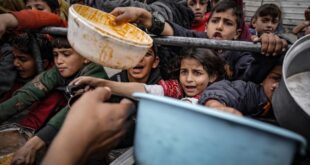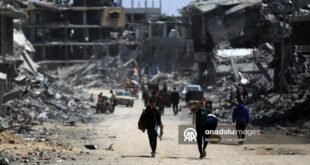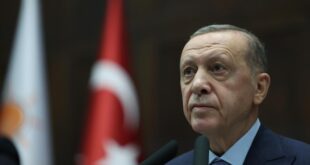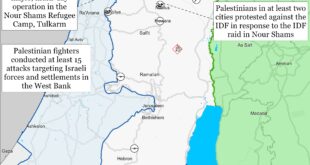Islamic State has faced considerable losses in recent years, but not enough to permanently prevent the organization from resurging.
On February 9, 2022, the United States-led Global Coalition to Defeat ISIS issued a communique stating that it “remains resolutely committed to achieving the enduring defeat of ISIS. Recent events in Syria underscore both the success we continue to have in degrading Daesh/ISIS leadership and the continuing threat the terrorist group poses in the region and beyond.” Is the terror organization close to making a comeback? Despite sporadic successes, it still has a long way to go.
Three-pronged attack
On January 20, 2022, Daesh – also known as ISIS or the Islamic State in Syria and Iraq – launched a surprise attack on the al-Sina’a prison in Al-Hasakah, a city in Syria’s far northeast. Their objective was to free some 3,500 of their militants held there by the Syrian Defense Forces (SDF). The move showed the world that the terrorist organization felt strong enough to resume its offensive and was still a force to be reckoned with.
Three years after the loss of the territorial basis of the Islamic Caliphate created by Abu Bakr al-Baghdadi, including over a third of Iraq and large tracts of northeast Syria, Daesh successfully carried out an impressive military operation. Some 200 fighters with state-of-the-art equipment and explosives were able to circumvent the security measures set up by the SDF and breach the prison walls. In the ensuing melee, hundreds of prisoners escaped.
With the fall of Al-Baghuz, Washington and its coalition partners assumed that ISIS was mostly over.The terrorists stood their ground for a whole week despite the efforts of the SDF, backed by U.S. air support and a small number of ground forces that had remained in the region. According to the Syrian Observatory for Human Rights, there were 159 casualties – 107 prisoners including Daesh fighters and 45 SDF soldiers. Another 800 escaped prisoners were subsequently caught.
The New York Times correspondents in Beirut and Baghdad reported that the operation was part of a three-pronged offensive. On the same day and at the same time, terrorists attacked a military outpost in the Iraqi Diyala Governorate, killing the 11 members of the garrison. A few days earlier, they had captured a high-ranking officer, later decapitating him on film as in the heyday of the Caliphate. ISIS’s purpose had been to demonstrate that it was no longer content with lone-wolf actions and could now muster hundreds of fighters for concerted military operations – a clear attempt at a comeback. However, for the time being, it does not seem to have the manpower to take over populated areas and administer them as in the not-so-distant past.
Serious setbacks
The SDF, which mostly comprises Kurdish fighters along with some Syrian rebels, were created with U.S. support. Trained by American army instructors and supplied with weapons, they were intended to be the spearhead of the U.S.-led global coalition to fight Daesh in northern Syria. They conquered a third of the country and set up a de facto Kurdish autonomous region, Rojava, driving away the remaining Daesh militants. In March 2019, they captured the last ISIS stronghold, Al-Baghuz, in the Deir ez-Zor region, near the Iraqi border and not far from the Abu Kamal Syria-Iraq border crossing through which Iran dispatches men and ammunition to its militia proxies in Syria.
With the fall of Al-Baghuz, Washington and its coalition partners, as well as Moscow and to a lesser degree Tehran, assumed that ISIS was mostly over. Yet hundreds of its fighters were still alive. They shaved their beards and melted into the general population, biding their time. Some Western experts warned of the danger, mentioning that small clusters were still active in the Syrian Desert, but nothing was done. Under President Donald Trump, the U.S. abandoned its faithful Kurdish allies and let Turkey invade Kurdish populated areas like Afrin in northern Syria.
Washington even announced that it was withdrawing all its troops from Syria, though it left some 700 soldiers east of the Euphrates River in Kurdish territory. There are also 200 American soldiers in the Al-Tanf garrison at the border between Syria, Iraq and Jordan, allegedly training anti-Assad rebel forces. Russia, which had taken an active part in the fight against Daesh, now focuses on keeping main roads open in Syria, sending planes to bomb Daesh militants when it receives relevant intelligence. Iran is intent on pushing the Kurds beyond the Euphrates in order to take over the huge oil fields they operate and set up outposts along the Iraqi border. The Iraqi and Syrian governments, for their part, are dealing with too many internal conflicts to keep track of Daesh.
As a result, the Kurds are left with the task of dealing with prisoners taken along the way. They number a staggering 12,000, including women and children. They are kept in makeshift jails, where they are supposed to be held until foreign fighters and their families can be deported back to their countries of origin to be tried there. Prisoners reportedly come from 50 different countries. Kurds also expect help in judging local fighters. Unfortunately, assistance is not forthcoming.
In the internment centers, there is not enough food and no proper medical supervision. In the al-Sina’a jail, there are 500 children and youngsters aged 12 to 17 who fought with their elders or are the children of fighters. They are now being brainwashed by more extreme factions who are grooming them to be the next generation of Daesh terrorists.
It soon became apparent after the fall of Al-Baghuz that the internal structure of the organization had not been destroyed and that communication links were still open, including online. It took only a few months before Daesh resumed posting on social media, publishing propaganda videos. Meanwhile, they were also attacking sparsely populated areas in the Syrian desert, levying taxes and foraging for food with impunity. They also lay roadside bombs targeting military patrols. In Iraq, the situation is worse because of the lack of coordination between pro-Iran militias and government forces on the one hand and the Peshmerga on the other. This allows jihadists to launch surprise attacks.
Daesh leader Ibrahim al-Hashimi al-Qurayshi, who killed himself by setting off a bomb on February 4 to escape capture by American special forces, had kept a low profile but still managed to orchestrate terrorist acts. The small-scale attacks turned major roads into danger areas, killing civilians and soldiers alike and becoming a major irritant to the security forces of Syria and Iraq. It gave a much-needed boost to the movement, which then felt strong enough to carry out the January 20 attacks. Experts are beginning to realize that Daesh is not rising from its ashes – it had never disappeared.
Origins of ISIS
Daesh is a radical Islamist group that emerged in the 20th century. It was influenced by the Muslim Brotherhood, created in Egypt in 1928 in reaction to colonialism and the fall of the Ottoman Empire. The Brotherhood’s calls for restoring the greatness of Islam and reviving the Caliphate fell on fertile grounds in an Arab world humiliated by colonial powers and state failure. In the first free elections carried out after the 2011 Arab Spring, the Muslim Brotherhood came to power in Egypt, Tunisia and Libya. Like al-Qaeda, Daesh is the offshoot of this Islamic awakening, which led to tens of thousands of volunteers from Islamic countries – and hundreds from Muslim communities in Europe – to join the organization in Syria and Iraq.
There will be no lasting victory until order is restored in war-torn Syria and neighboring Iraq.At its peak, ISIS set up branches throughout the Middle East in the hope of reviving an Islamic Caliphate. It sent advisors and commanders, supplied them with contraband weapons and taught them how to inflict as much damage as possible in their host countries. Saudi Arabia ultimately eradicated the threat, and Egypt is in the process of quelling the Sinai insurgency. Libya has not been able to do so, and neither has Somalia. Farther afield Daesh has been eliminated in the Philippines but is still active in Pakistan and Afghanistan, where it challenges the new rulers. Of particular concern is the situation in the Sahel region of West Africa. Deadly terror attacks are being carried out despite the presence of French troops assisted by units of the Organization of African States. There have also been individual attacks in Europe directly ordered or inspired by Daesh.
These activities are made possible by the war chest of the movement, which comes from the levies it raises from people and institutions, donations from Arab states disguised as humanitarian assistance, material support from foreign fighters as well as fundraising through social networks. It also draws from whatever is left of its past assets, including millions of dollars allegedly looted from Mosul banks. Daesh’s ideology is deeply rooted in Islamic tradition and culture, which makes it difficult for Arab states to eradicate it.
Scenarios
The organization appears to have found a new lease on life despite devastating defeats and the loss of its territorial basis. On March 10, it announced that it had already chosen a new Caliph, Abu al-Hassan al-Hashimi al-Qurashi. This should be a wake-up call not only for the states where ISIS is active, but also for the members of the coalition that failed to take enough measures to prevent this revival. The U.S. and its allies did not grasp the religious, political and social dimension of the phenomenon. They were blind to the fact that radical Islam could and did escape the confines of the Middle East and challenge the intelligence services of Western countries and the world at large.
A new coalition is unlikely to be formed any time soon to combat this rejuvenated Daesh. The organization will intensify its attacks and will make renewed efforts to free its thousands of imprisoned members, which it badly needs to swell its ranks. Syrian and Iraqi armies are fighting proxy wars at home and will be hard put to stop frenzied fighters ready to die in pursuit of what they see at the will of Allah. Of particular concern for Europe is the threat to West African countries. Ultimately, a reluctant Washington could be dragged back into the region and tasked with assisting the SDF, including with air power. But there will be no lasting victory until order is restored in war-torn Syria and neighboring Iraq.
 Eurasia Press & News
Eurasia Press & News




